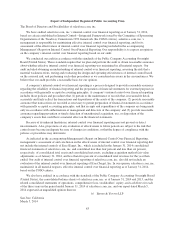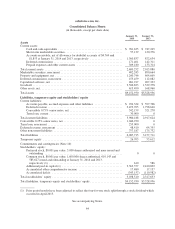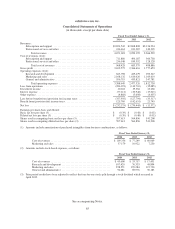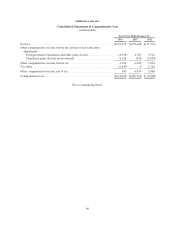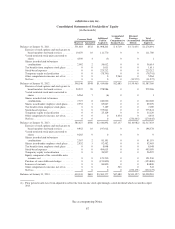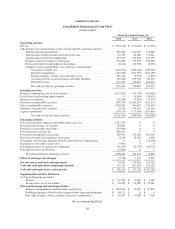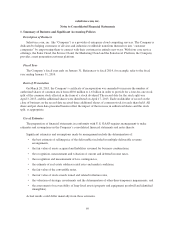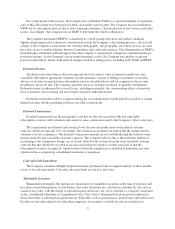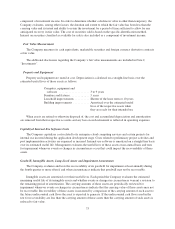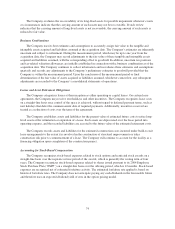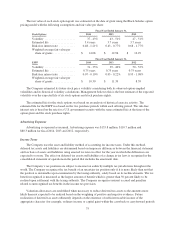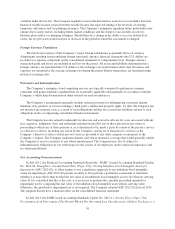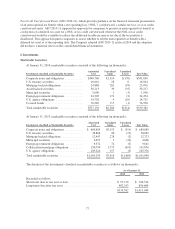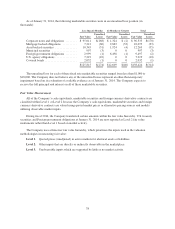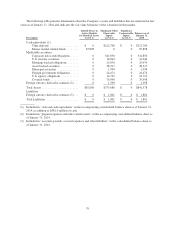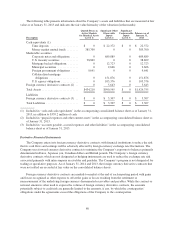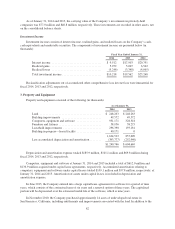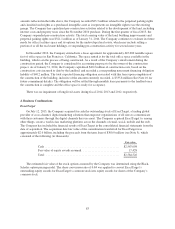Salesforce.com 2014 Annual Report Download - page 77
Download and view the complete annual report
Please find page 77 of the 2014 Salesforce.com annual report below. You can navigate through the pages in the report by either clicking on the pages listed below, or by using the keyword search tool below to find specific information within the annual report.component of investment income. In order to determine whether a decline in value is other-than-temporary, the
Company evaluates, among other factors: the duration and extent to which the fair value has been less than the
carrying value and its intent and ability to retain the investment for a period of time sufficient to allow for any
anticipated recovery in fair value. The cost of securities sold is based on the specific-identification method.
Interest on securities classified as available for sale is also included as a component of investment income.
Fair Value Measurement
The Company measures its cash equivalents, marketable securities and foreign currency derivative contracts
at fair value.
The additional disclosures regarding the Company’s fair value measurements are included in Note 2,
“Investments”.
Property and Equipment
Property and equipment are stated at cost. Depreciation is calculated on a straight-line basis over the
estimated useful lives of those assets as follows:
Computer, equipment and
software ..................... 3to9years
Furniture and fixtures ............. 5years
Leasehold improvements .......... Shorter of the lease term or 10 years
Building improvements ........... Amortized over the estimated useful
lives of the respective assets when
they are ready for their intended use
When assets are retired or otherwise disposed of, the cost and accumulated depreciation and amortization
are removed from their respective accounts and any loss on such retirement is reflected in operating expenses.
Capitalized Internal-Use Software Costs
The Company capitalizes costs related to its enterprise cloud computing services and certain projects for
internal use incurred during the application development stage. Costs related to preliminary project activities and
post implementation activities are expensed as incurred. Internal-use software is amortized on a straight line basis
over its estimated useful life. Management evaluates the useful lives of these assets on an annual basis and tests
for impairment whenever events or changes in circumstances occur that could impact the recoverability of these
assets.
Goodwill, Intangible Assets, Long-Lived Assets and Impairment Assessments
The Company evaluates and tests the recoverability of its goodwill for impairment at least annually during
the fourth quarter or more often if and when circumstances indicate that goodwill may not be recoverable.
Intangible assets are amortized over their useful lives. Each period the Company evaluates the estimated
remaining useful life of its intangible assets and whether events or changes in circumstances warrant a revision to
the remaining period of amortization. The carrying amounts of these assets are periodically reviewed for
impairment whenever events or changes in circumstances indicate that the carrying value of these assets may not
be recoverable. Recoverability of these assets is measured by comparison of the carrying amount of each asset to
the future undiscounted cash flows the asset is expected to generate. If the undiscounted cash flows used in the
test for recoverability are less than the carrying amount of these assets then the carrying amount of such assets is
reduced to fair value.
73


